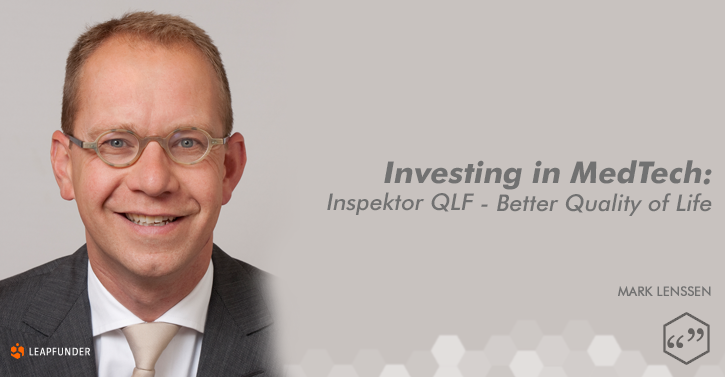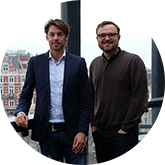Mark Lenssen is founder of Zorgfunders, an initiative for crowdfunding & networkfunding of healthcare institutions in the Netherlands. Zorgfunders is currently consulting Inspektor QLF, a company developing dental diagnostic devices,to raise convertible notes through the Leapfunder platform. We take the opportunity to interview Mark about this deal and his motivations for starting Zorgfunders.
Interview with Mark Lenssen on investing in MedTech
1. Hi Mark, good to have you. Let’s start by asking you some questions about your background. You have a background in management consulting and healthcare consulting, in organisations such as AT Kearney and Plexus. In addition, you have co-founded a venture capital fund focused on healthcare (Capital Care Partners, now Holland Venture Health Innovation Fund). Can you tell us something about this and how you came up with the initiative to start Zorgfunders?
Sure, I have been working in the Dutch healthcare industry for over 15 years now. My passion is to stimulate innovations which can guarantee or better improve the efficiency, quality and accessibility of health care. I believe private investors can play an important role in this respect, especially when these investors bring more to the table than only money, like a relevant network and knowledge. Crowdfunding or network funding can help putting this into practice. Last year an entrepreneur proved this by crowdfunding the last financial needs of a new health insurance provider, ANNO12 in the Netherlands. He established a community over the last 3 to 4 years which helped him achieving his goals. Zorgfunders aims at supporting Dutch crowdfunding initiatives by unlocking existing health care communities which the entrepreneur can address besides his own community and in this way accelerate the deployment of promising innovations.
2. Can you tell us something about the issues you came across in the funding of Dutch healthcare initiatives, and the opportunities?
The opportunities are unlimited, after all these years I am still surprised how many innovations, both technological and organizational, are developed in the Netherlands. In this respect it helps that knowledge institutes like academic hospitals begin to have a different view towards research. Until recently, the only/main goal of a research project was to publish the results into a highly respected international journal and move onto the next research project. Nowadays, there is a tendency that the publication of a successful project is only the beginning of a journey towards market deployment.
The largest issue is the enormous throughput time between pilot results of a promising healthcare innovation and actual deployment of the innovation on a larger scale. Only part of it can be explained by the thorough validation process you need to go through. Another reason is the ‘not invented here syndrome’ which is present throughout the whole industry: ‘if somebody else has invented it, it can not be right for me’. I am convinced that giving individuals the opportunity to participate in an early stage, the ownership of new innovations is felt more by society and therefore the willingness to help deploying the innovation.
3. The big success of Zorgfunders this year was eNose, a company developing a sensor for detecting cancer based on ‘smell’. eNose raised EUR 380,500. What type of investors did invest in this project? Was the majority of investors acquainted with investing in health care?
About 130 individuals invested in The eNose company, which leads to an average investment of about EUR 3,000 per person. The majority of these persons invested between EUR 250 – EUR 1,000. These persons were not acquainted with investing in health care. Making a return on their investment was not their only motivation, contributing to a promising development was as much as important. Besides these smaller investors, there were a dozen investors, investing EUR 10,000 or more per person. Most of these investors were experienced informal investors or active in the healthcare industry and convinced of the possibilities the eNose can offer on the short term.
4. What are the drivers of people to invest in healthcare? Do you you believe it is interesting for investors without a background in medical technology to invest in medical technology?
It mainly depends what your goal is and how much risk you are willing to take. If your main goal is to make a bit more return than the interest on your savings account and not to take too much risk, I would not recommend investing in healthcare. Other industries are likely to be more predictable and therefore less risky. If you are willing to take a risk and also willing to accept that some investments will not lead to any return, the healthcare industry itself is interesting. The industry keeps on growing, perhaps with a smaller growth rate than the last decades, but is at least growing and the demand for better health care is likely to stay. However, it is difficult to predict which innovations and companies will be the future winners, also for experienced investors. Therefore I would recommend that investors without any background should try to team-up with experienced medtech investors in order to improve the chances of success.
5. Do you perform screening of the projects that you advice with their campaign? If yes, what kind of screening?
When I discuss potential projects I look for a couple of things. First of all, does the innovation contribute to better healthcare in terms of improved efficiency, quality and/or accessibility. Furthermore I look for a ‘scientific’ substance of the innovation: was an external knowledge institute involved in developing or validating the innovation? What helps as well if the entrepreneurs, informal investors or formal investors have invested already or are willing to invest in the innovation. In that respect I try to judge whether the investor looks at crowdfunding only as last resort to get financing or also values the strategic advantages of creating an involved network. And of course I have a look at the financials, both the business plan of the company and the ‘societal business case’ of the innovation. Finally I discuss the overall required investment and the likelihood that at least a part of it can be addressed via crowdfunding / networkfunding.
In general I do not turn projects down explicitly, but give them some brief advice what their next steps could be and in some cases these steps do not involve crowdfunding.
6. Your last two projects have been medical devices. Do you also do other types of healthcare projects, such as biotechnology or health care services?
Yes, currently I am discussing multiple biotech projects, but likely they will not all lead to a campaign. Especially with these kind of projects it is important to me that other investors (informal or VC) participate as well. I also discuss health care services projects, although the investment need in general is much less than medtech and biotech.
7. The current project you are advising is Inspektor QLF. Can you tell us something about this project. Why is this technology interesting in your opinion?
Inspektor QLF has developed a technology that makes pictures of our teeth using fluorescent light. In this way these pictures can give much more, objective information about the condition of our teeth than the traditional X-ray picture or the visual inspection of the dentist. In addition an algorithm has been developed which makes it possible to ‘score’ the condition of the teeth on a scale of 0 – 5. So far the technology has been used globally by research institutes and clinical departments of toothpaste producers. Inspektor QLF has developed a camera which makes this technology available for dental professionals. In this way, evidence based treatments will be more possible and the pictures can be used to communicate to patients how they should change their brushing habits. Finally, this technology provides the opportunity to implement outcome financing for a EUR 3+ billion industry in the Netherlands only.
8. What kind of possibilities do you see in the future for the funding of healthcare?
I expect that mixed-financing is going to increase, combining traditional funding with new ways like crowdfunding and network funding. We’ve already seen some big international successes, such as Rewalk Robotics (crowdfunded, and then IPO in September 2014) and I think there only will be more such examples in the future. Using crowdfunding, both larger funding tickets will become possible and the impact of an involved network will increase. Less experienced investors with an interest in healthcare can now team up with more experienced healthcare investors to fund the technologies of the future. This is something that was not previously possible.
Thank you very much Mark! Inspektor QLF is now live on Leapfunder.com, check it out and improve the efficiency, quality and accessibility of health care!



